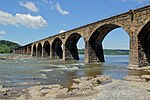Seven Gates of Hell
Urban legendsYork County, Pennsylvania

The Seven Gates of Hell is a modern urban legend regarding locations in York County, Pennsylvania. Two versions of the legend exist, one involving a burnt insane asylum and the other an eccentric doctor. Both agree that there are seven gates in a wooded area of Hellam Township, Pennsylvania, and that anyone who passes through all seven goes straight to Hell. The location in question never housed an institution; the aforementioned doctor only constructed one gate, to keep out trespassers. Despite the popularity of this as a tourist destination, the property is privately held; visitors may be charged with trespassing as a result.
Excerpt from the Wikipedia article Seven Gates of Hell (License: CC BY-SA 3.0, Authors, Images).Seven Gates of Hell
Toad Road, Hellam Township
Geographical coordinates (GPS) Address Nearby Places Show on map
Geographical coordinates (GPS)
| Latitude | Longitude |
|---|---|
| N 40.039671 ° | E -76.661692 ° |
Address
Toad Road
Toad Road
17406 Hellam Township
Pennsylvania, United States
Open on Google Maps








